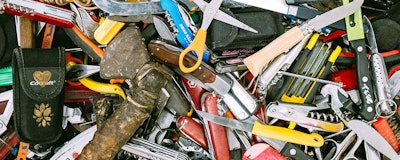
Lacerations are one of the most common workplace injuries. The good news is that they’re largely preventable. Achieving a laceration-free workplace isn’t difficult if you apply some focused strategies.
Why Focus on Lacerations?
Health and safety managers have so many areas to focus on: Why should they make laceration prevention a priority?
Preventing a common injury gives you greater results for your effort. That is, eliminating the most common injuries should, statistically at least, reduce the highest number of injuries.
Lacerations are costly, in many ways. There’s the cost of pain to the person who got cut: lacerations hurt! Even small paper cuts are annoyingly painful. And when you’re working with dangerously sharp cutting tools, it doesn’t take much to create a laceration that’s much more serious than a paper cut. Deeper, larger cuts may require stitches, surgery, rehabilitation, and even permanent disability.
Most lacerations in the workplace are to the hands and fingers, and most jobs require healthy hands and good dexterity. Add to that the fact that hands are neuromuscularly complex, so they’re difficult to fix and heal. Preventing hand injuries, then, is important.
Lacerations are a financial burden. OSHA estimates that a company will spend, on average, $41,000 in direct and indirect costs for a single laceration.
Consider too that any laceration that requires more than a first aid kit—if someone needs stitches, for example—will be an OSHA recordable incident, and will count toward your Total Recordable Incident Rate. That has long-lasting repercussions of its own.
Now that you’re inspired to prevent lacerations, let’s jump into how it can be done.
Laceration Prevention
1. Maintain All Cutting Tools
Tools that are in good working order are far less likely to malfunction. This is especially important when the tool features a cutting blade. The most important part of a cutting tool to maintain is the blade: never use a dull blade. When blades are not at an effective sharpness, they require more pressure to make a cut, which can easily lead to slippage. Besides, when you’re cutting with a dull blade, your cut will likely not be clean.
Make sure that no parts are loose or rattle. If there are moving parts: Do they function smoothly? Does the tool hold the blade firmly in place?
To make sure tools remain in good shape, check them regularly. Consider creating a checklist of all cutting tools, and schedule monthly or weekly maintenance reviews. If cutting tools are in heavy demand in your workplace, stock replacement blades and replacement cutting tools. This will help workers avoid the temptation to keep using a broken tool because they don’t have a suitable alternative.
2. Provide PPE That Fits and Is Well Maintained
PPE also needs to be in good working order, and it needs to fit properly. For laceration prevention, the two most important PPE items are gloves and eye protection. But scratched up glasses that fall off someone’s head aren’t going to cut it. A pair of gloves that are too big will actually cause more problems than they’ll prevent.
For workers who use cutting tools often, they should have their own PPE. If workers share PPE, makes sure you have sizes that fit everyone. Gloves also offer different levels of cut protection: make sure your workers have the appropriate gloves for the job.
Glasses come in various styles and sizes, as well as lens colors. Again, make sure your workers have the glasses they need to get their job done safely. To keep up on maintenance, add PPE to your cutting tool maintenance checklist.
3. Provide New-Hire and Frequent Refresher Safety Training
Safety training is critical to keep workers injury-free. No worker should be allowed to start work until they understand safety protocols and that there is a no-tolerance policy towards protocol violations.
It’s common for workers to become complacent when they’ve been doing the same job for some time. Confidence sometimes results in laziness when it comes to following rules to the letter. This is why it’s important to remind workers about the need to follow protocols every single time. Even a short refresher will do, like including cutting safety as one of your safety moment topics.
4. Promote “Staying Aware to Stay Safe”
Lack of awareness is a major contributor to many workplace injuries. Workers can be stressed, distracted, tired, in a rush—all of which contribute to not paying attention. This is a big problem if you’re using a cutting tool: it puts the user and those nearby in danger.
As part of your safety training, remind workers to take a beat or a deep breath before using any dangerous tool. Remind them to look around, make sure they and the item they’re cutting are on firm ground before they begin. Taking only a few seconds to focus awareness on the task at hand and your surroundings will help reduce injuries.
5. Chose the Safest Cutting Tools
Since the tool is what ultimately causes the injury, make sure your workforce is outfitted with the most effective safety knives. The safety features of most cutting tools focus on handle design and limiting blade exposure, which is helpful. But there’s still a dangerously sharp blade to contend with, and that’s what cuts you. Look for safer blade design.
Look for tools that are well constructed and made of durable materials: flimsy knives aren’t safe. Choose cutters that are ergonomic: Are they comfortable to use? Do they allow for a natural motion? Ergonomic tools cut down on fatigue and provide a firm grip, which helps reduce mishaps and injury.
A safe workforce is a happier, more productive workforce. It doesn’t take much to cause a laceration, but it doesn’t take too much to prevent one either. Your efforts here will be well spent.
T.J. Scimone is founder and owner of Slice, Inc, maker of unique safety cutting tools, like a safer utility knife, featuring patent-pending finger-friendly blades.
 T.J. Scimone, Founder and owner of Slice, Inc
T.J. Scimone, Founder and owner of Slice, Inc






















